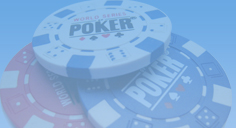Pot Odds : Calculating Pot Odds
Pot odds play an important part in the game of poker. Poker is a game of decisions. Do i play the hand. Do i make the call. Sometimes the decisions are easy, other times it is more marginal. Understanding the pot odds is beneficial as it can give us a pointer as to whether we are getting the right price to call a bet.
The pot-odds is the ratio of what is already in the pot to the amount you would have to bet to stay in the hand. If there is $36 in the pot, and you need to bet $6 to stay in the hand, the pot odds are 36 / 6 or 6 to 1. They are often expressed as a win-to-loss ratio and may be converted into percentages using the formula: win-to-loss odds = win / (win + loss) % probability.
Pot Odds to Aid The Decision Making Process
Ok, on their own they don't give us the complete picture .Getting 6-1 on our money is great. Getting 66-1 on our money is even better. Does that mean we take the punt? No. Pot odds are used in conjunction with the odds of making out hand. We can calculate this as we can work out the number of cards that could make us a winning hand and the number of unseen cards left in the deck, to determine the likely hood of us hitting one of this cards.
For example suppose we have four cards on the board (turn) you hold four clubs, needing one more to make your flush. We know we started with 52 cards. We have two and there are 4 on the board. That's 46 cards that we cannot see (burn cards, opponents hands and left in the deck). We know there are 13 of each suit in a deck and 4 are visible. That means there are 9 left that could be dealt. So 9/46 = 5.1. These are the odds we will hit one of the remaining cards needed or if we played the hand 5 times, we would hit once.
Using the example above, we were faced with a bet of $6 into a pot of $36 (6/1). If we had odds of making a winning hand of 5-1 and pot odds of 6-1, we should make the call. If our odds of hitting was higher than the pot odds, we would fold. We need to remember that these are the odds at best. One of the remaining suited cards we need could be a burn card or in an opponents hand.
Suppose there were $120 in the pot and you faced a $10 bet at 5 to 1 to hit? Hitting your hand would pay you over 12 to 1 and you would hit roughly every 5 times you played the hand. That makes calling the bet the right decision to make. You may not land your club and win the hand, but over the long run playing this way will be to your advantage as you will making money.
To prove it the maths is sound, lets take a look.
Faced with the $10 bet, lets play the hand 24 times. That's an investment of $240. With 5-1 on winning the hands, played 24 times we would win just over 4 times. 4 x 120 = $480. So we invest $200 to win $480.
There will be times when you feel your opponent may have the better hand, but you are getting the right price to call. Being able to use pot odds will help you answer that question correctly more often. Making the right decision can be the difference between winning and losing.
Implied Pot Odds
Implied Pot Odds are used when there are more cards to come and so more betting. These odds are used when your hand is an almost certain loser but may improve to be a certain winner (i.e. improving from no pair to a nut flush). A player's implied pot is the current pot plus the value of future bets expected from all opponents that may be won, excluding the player's own bets. When calculating the implied pot you must estimate the bets that you expect your opponents to make. Sounds more tricky than it actually is.
Lets look at an example. I hold Ace ![]() , King
, King ![]() and the flop reads 3 diamonds meaning that I only need one more to make my nut flush. I am now faced
with a $5 bet to win a pot of $20 - what do I do? Well lets look at my implied pot. If I call I
expect roughly a $10 bet on the turn and river meaning that my implied pot is $40. Now my effective
call is $15 ($5 on the flop and $10 on the turn) to $40 (15 / (15 + 40) or 27%. If I was to
call the $5 bet I would have a positive expectation as with 2 cards to come I have approximately a
35% chance of hitting my Diamond to make my nuts flush. Now as my implied odds are 27% I am making
the right move calling. If my implied odds were less than 27% then I should fold.
and the flop reads 3 diamonds meaning that I only need one more to make my nut flush. I am now faced
with a $5 bet to win a pot of $20 - what do I do? Well lets look at my implied pot. If I call I
expect roughly a $10 bet on the turn and river meaning that my implied pot is $40. Now my effective
call is $15 ($5 on the flop and $10 on the turn) to $40 (15 / (15 + 40) or 27%. If I was to
call the $5 bet I would have a positive expectation as with 2 cards to come I have approximately a
35% chance of hitting my Diamond to make my nuts flush. Now as my implied odds are 27% I am making
the right move calling. If my implied odds were less than 27% then I should fold.
Other Considerations
Another consideration when calculating whether to stay in a hand or not is not to forget that many of your cards may be in other players hands. For instance if you hold K-J and have a straight draw needing and Ace or Ten to make your hand, if you had 4 or 5 limpers into the pot, we need to consider our opponents. For instance, we already know our opponents may hold some of our outs. If we know they are far more likely to be playing face cards, there's a higher chance that we are minus some remaining aces, possibly our 10's also.
It's not an easy one to apply to our calculations. We could call a big bet and hope we hit.. Even though we might think our opponents ranges are all over our remaining, we need to consider the following:
- If the other players were more likely to have high cards inside your hitting range, then you are more likely to hit your ten.
- If the other players were more likely to have high cards, then they would also need high cards to improve so their chances for improvement are lessened also
As such under these scenario raising would be a better play, at least to see where you are in the hand.



Popular Top-Lists
Recommended Visit













 Top UK Poker Options
Top UK Poker Options